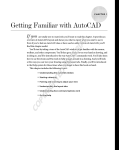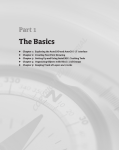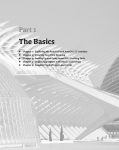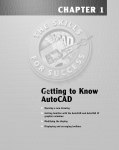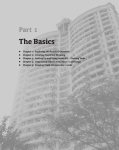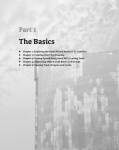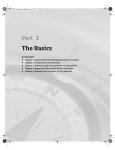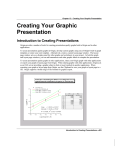Download Wiley Just Enough AutoCAD 2007
Transcript
0878book.fm Page 1 Wednesday, March 15, 2006 8:31 PM Chapter 1 Getting Familiar with AutoCAD If you are totally new to AutoCAD, you’ll want to read this chapter. It provides an overview of AutoCAD’s layout and shows you what to expect when you start to use it. Even if you’ve had a class or have used an older version of AutoCAD, you will find this chapter useful. You’ll start by taking a tour of the AutoCAD window to get familiar with the menus, toolbars, and other components. You’ll then get a chance to try your hand at drawing, and, in doing so, you’ll be introduced to the way AutoCAD’s commands work. You’ll also learn how to use the Zoom and Pan tools to help you get around in a drawing. And you’ll take a look at the ways you can view your drawing using the layout tabs. Finally, you’ll be introduced to the Help system for those times when you forget to have this book on hand. This chapter includes the following topics: ◆ Understanding the AutoCAD Window ◆ Starting a Drawing ◆ Panning and Zooming to Adjust Your View ◆ Understanding the Layout Tabs ◆ Understanding How Command Options Work ◆ Getting Help Understanding the AutoCAD Window Autodesk has completely redesigned AutoCAD 2007’s set of 3D modeling features and to show them off, AutoCAD’s default opening window prominently display these new features. If you’ve used AutoCAD before, it will appear as though AutoCAD has completely changed. Don’t worry; it hasn’t. As a new user, you may only be slightly confused since AutoCAD is primarily thought of as a 2D drawing program. In this beginning section, you’ll open AutoCAD to it’s default window, then you will switch to the AutoCAD “classic” window. While Autodesk has made it much easier to work in 3D, as a new or return user, you’ll want to start out with the basic 2D operations. TIP If you’re feeling adventurous, you can go to Chapter 6 to find our more about AutoCAD’s new 3D tools. AutoCAD works like most other Windows-based graphics programs, but it also has a few quirks. This section gives you an overview of AutoCAD’s layout. Although many elements will be familiar, a few will be new to you. 0878book.fm Page 2 Wednesday, March 15, 2006 8:31 PM 2 CHAPTER 1 GETTING FAMILIAR WITH AUTOCAD To start out, you'll take a look at the two different ways that AutoCAD displays a drawing. Then for the rest of this chapter, you'll focus on the 2D drawing environment. After installing AutoCAD, take the following steps: 1. Choose Start All Programs Autodesk AutoCAD 20072007 AutoCAD 2007. You can also double-click the AutoCAD 2007 icon on your Windows Desktop. LT users will click AutoCAD LT 2007 in place of AutoCAD 2007. If you have Windows XP set to the Classic start menu, you will see Start Programs instead of Start All Programs. The open greeting, called a splash screen, appears momentarily, then if this is a new installation, AutoCAD will display the Workspaces message box. This message box offers an option to select either 3D Modeling or AutoCAD Classic. After the splash screen closes, you see the AutoCAD window with a blank default document named Drawing1.dwg as shown at the top of Figure 1.1. If this is a new installation, you will also see the New Features Workshop window. If this happens, select Maybe Later, then click OK. 2. Select 3D Modeling and click OK to get a glimpse of AutoCAD's latest innovations. NOTE In some installations, you may see a Startup dialog box. If this happens to you, click Cancel, and AutoCAD will display the blank default document. 3. The default document appears to be an empty, gray 3D space. You also see a special tool palette called the Dashboard. This is a set of 3D modeling tools that let you easily create 3D designs. You’ll get a closer look at these tools in Chapter 6 but to get familiar with AutoCAD, you’ll switch to the “classic” AutoCAD display. 4. In the upper-left corner of the AutoCAD window, you’ll see a drop-down list that shows 3D Modeling. 5. Click this drop-down list and select AutoCAD Classic. The window will change to look more like the one shown in the bottom half of Figure 1.1. Notice that this list contains the same two options found in the Workspaces message box at appears in step 1. 6. The current default file, drawing1.dwg, is set up for 3D modeling, including a perspective view. For this chapter, create a new file set of for 2D by choosing File New. The Select Template dialog box appears. 7. Select acad.dwt from the list and click Open. A new file called drawing2.dwg appears. 0878book.fm Page 3 Wednesday, March 15, 2006 8:31 PM UNDERSTANDING THE AUTOCAD WINDOW You’ve got AutoCAD set up for 2D drawing, so let’s take a more detailed look at the AutoCAD window. You’ll find that, for the most part, it is a typical Windows-style graphics program window with a few twists. Figure 1.1 AutoCAD as it first appears when opened into a 3D Modeling workspace in the top image or the AutoCAD Classic workspace in the bottom image. 3 0878book.fm Page 4 Wednesday, March 15, 2006 8:31 PM 4 CHAPTER 1 GETTING FAMILIAR WITH AUTOCAD Changing 3D Views to 2D Views and Back Even though the opening file in AutoCAD's 3D Modeling workspace looks completely different from the new 2D file you create using the acad.dwt template, they really are basically the same. They just have different display settings turned on. You can change the default drawing1.dwg 3D view to a 2D view by doing the following: 1. Choose View Visual Styles 2D Wireframe. 2. Choose View 3D View Plan View World UCS Your 3D view changes to look like a typical 2D drawing. Likewise, you can convert a 2D view into a 3D one: 1. Choose View Visual Styles Realistic 2. Choose View 3D Views SE Isometric 3. Enter Perspective ↵1↵ to turn on the perspective view. 4. Click the Grid button in the status bar at the bottom of the AutoCAD Window. The file that started out with a 2D view now shows your drawing in 3D. Getting to Know the Window Components The AutoCAD window is made up of several parts that are common to most Windows graphics programs: ◆ Menu bar ◆ Docked and floating toolbars ◆ Drawing area ◆ Command window ◆ Status bar ◆ Tool palettes ◆ Properties palette The Tool palettes and Properties palette may not appear on the screen, but you can easily retrieve them by clicking buttons on the toolbar at the top of the AutoCAD window. If you don’t see them, don’t worry. At this point, they aren’t essential for new users. Your AutoCAD window should look like Figure 1.1, which shows the default configuration for a new AutoCAD installation. Since AutoCAD is so easily customizable, you may not see exactly the same layout, but the basic components should be there. As with typical Windows programs, AutoCAD has a menu bar along the top that contains most of the common functions you’ll need to work with (see Figure 1.2). Below that are toolbars for quick access to settings and the more common drawing and editing tools. You also have toolbars to the right and left of the window. The Draw toolbar at the left contains tools you use to place new objects in your drawing, and the Modify toolbar at the right contains tools you use to edit objects. These toolbars provide the same functions as the Draw and Modify menu bar options. 0878book.fm Page 5 Wednesday, March 15, 2006 8:31 PM UNDERSTANDING THE AUTOCAD WINDOW Figure 1.2 Menu bar The components of the top of the AutoCAD window Workspace toolbar Standard toolbar Layers toolbar Styles toolbar Properties toolbar In the middle is the drawing area where you will do your actual drawing. One difference between the bottom of Figure 1.1 and what you see on your screen is that the background in the default AutoCAD drawing area is black. This helps with the visibility of lines on the computer screen. But in this book, you will see the drawing area background shown in white because in print, drawings with a white background are easier to see. At the bottom of the screen is the status bar, which provides information regarding many of the settings you’ll use in AutoCAD. Just above the status bar is the Command window, which is somewhat unique to AutoCAD. You’ll learn more about the Command window a bit later in this chapter. Just as you can do in other Windows programs, you can move toolbars and reshape them to your liking. The default location of the toolbars is in their docked position, which just means that they are merged with the outer edge of the window to save space. You can drag them out into the drawing area and reshape them if you like, or you can reposition them anywhere in the screen. When toolbars are moved away from the edge of the window and appear “free floating,” they are said to be floating toolbars, as opposed to docked. Another unique item in AutoCAD’s window is the set of Tool palettes shown in Figure 1.3. These palettes let you keep your favorite tools and drawing components in one convenient place for quick access. Now let’s look at some important parts of the AutoCAD window. The drawing area, the status bar, and the Command window work together to give you feedback while you create and edit your drawing. As you move your cursor over the drawing area, you’ll see the cursor appear as a crosshair. If you click in the drawing area, a pair of numbers and a selection window appears. Click again and the rectangle and selection window disappear. The crosshair lets you point to portions of the drawing area, while the numeric display, known as the Dynamic Input display, tells you your XY coordinate within the drawing area. The selection window lets you select objects in the drawing area. You’ll learn more about coordinates in AutoCAD in Chapter 2. You’ll look at selection windows a bit later in this chapter. As you work with AutoCAD commands, the Dynamic Input display changes to text prompts to aid you in determining what to do next. 5 0878book.fm Page 6 Wednesday, March 15, 2006 8:31 PM 6 CHAPTER 1 GETTING FAMILIAR WITH AUTOCAD Figure 1.3 The Tool palettes If you don’t see the Dynamic Input display, go to the bottom of the AutoCAD window to the status bar and click the DYN button . This is the Dynamic Input setting. Along with the Dynamic Input display, the Command window and status bar just below the drawing area provide feedback as you work with AutoCAD commands (see Figure 1.4). You can also see the XY coordinate in the far left of the status bar in the lower-left corner of the AutoCAD window. Figure 1.4 The status bar and the Command window work with the drawing area to give you feedback as you draw. Tab Selection arrows Model and Layout tabs Coordinate readout Command window Command prompt Communication Center Status bar 0878book.fm Page 7 Wednesday, March 15, 2006 8:31 PM UNDERSTANDING THE AUTOCAD WINDOW Controlling the Status Bar Display To the far right of the status bar, you’ll see a downward-pointing arrow, which opens a menu that controls the display of the status bar. You use this menu to turn the items in the status bar on or off. A checkmark by an item indicates that it is currently on. If for some reason you do not see all the buttons mentioned in the previous discussion, check this menu to make sure that all the status bar options are turned on. Note that LT does not have an Otrack option in the status bar. Finally, you’ll notice a set of tabs that appear between the drawing area and the Command window. These tabs provide two types of drawing views. By default, you see the Model tab. This is where you do most of your drawing and editing. The Layout1 and Layout2 tabs provide a way to set up your drawing for printing. You’ll learn more about layout tabs later in this chapter and in Chapter 11. TIP In a new installation of AutoCAD, you will see a message balloon in the bottom-right corner of AutoCAD. This message balloon alerts you to the latest news and information regarding AutoCAD through a feature called the Communication Center. Getting Familiar with the Drawing Area As you might imagine, the drawing area in the middle of the AutoCAD window is the space where you’ll be spending a lot of time. It pays to get a feel for how it behaves early on. As your introduction to the drawing area, try the following exercise. 1. Move the cursor around in the drawing area. As you move, notice how the Dynamic Input display changes to tell you the cursor’s location. It shows the coordinates in an X, Y format. The coordinate readout in the status bar also shows X and Y coordinates, but it adds the Z coordinate. 2. Place the cursor in the middle of the drawing area and click the left mouse button. You have just selected a point. Move the cursor, and a rectangle follows. This is a selection window; if there are objects in the drawing area, this window allows you to select them for editing. Also notice that you see the words Specify opposite corner in the Dynamic Input display. This tells you that you have started a selection window and you need to select the opposite corner for the window. 3. Move the cursor a bit in any direction; then click the left mouse button again. Notice that the selection window disappears. Had there been objects within the selection window, they would be selected. This is similar to the way the mouse cursor behaves on the Windows Desktop, only in Windows, you have to click and drag the mouse button to create a selection window. 4. Try selecting several more points in the drawing area. Notice that as you click the mouse, you alternately start and end a selection window. As you click inside the drawing area, you may notice that, depending on whether you click to the right or the left of the last point, the selection window displays a different color. If you click from left to right, the selection window appears blue. From right to left, it’s green. These colors indicate a different mode of selection, which you’ll learn about a bit later. 7 0878book.fm Page 8 Wednesday, March 15, 2006 8:31 PM 8 CHAPTER 1 GETTING FAMILIAR WITH AUTOCAD If you click the right mouse button, the shortcut menu appears. Just as with most other Windows applications, a right mouse click frequently opens a menu that contains options that are context sensitive. This means that the contents of the shortcut menu depend on where you right-click as well as the command that is active at the time of your right-click. If there are no applicable options at the time of the right-click, AutoCAD treats the right-click as ↵ . You’ll learn more about these options as you progress through the book. For now, if you happen to open this menu by accident, press the Esc key to close it. Finally, as with any window, you can expand the drawing area or contract it into a smaller window by clicking on the Maximize/Minimize icon in the upper right corner of the draw area. If the drawing is maximized, this icon appears just above the Styles toolbar. When the drawing area is minimized, it appears as a separate window within the AutoCAD Window. You can then resize the window to any rectangular shape you need. This is helpful when you have multiple AutoCAD Drawing files open. The ↵ symbol is used in this book to denote the Enter key. Whenever you see it, press the Enter key, also known as the Return key. TIP The UCS Icon The UCS icon is the L-shaped icon you see at the lower-left corner of the drawing area. It helps you see your orientation at a glance by pointing to the positive X and Y directions. UCS stands for User Coordinate System. That name is a hint that you can create and use other coordinates besides the default one that exists in new drawings. The default X direction is from left to right, and the Y direction is bottom to top, but AutoCAD lets you alter your view orientation as well as include additional coordinate systems that can be oriented in different directions. The UCS icon is especially helpful when you start to use these other coordinate systems and display modes, but right now, just be aware that it is there to help you get your bearings. You might notice a small square at the base of the UCS icon. This square tells you that you are in the World Coordinate System, which is the base coordinate on which other coordinate systems can be built. You’ll learn more about the UCS in Chapter 5. The Command Window The horizontal window at the bottom of the AutoCAD window is called the Command window. Besides the drawing area, this is where you can get feedback from AutoCAD. It is also where you can type commands and command options. The Command window shows two lines of text. As you work in AutoCAD, the command activity appears in the bottom line of the Command window and scrolls upward. When AutoCAD is waiting for input, you see the word Command: at the bottom of the Command window. This is called the Command prompt. As you click a point in the drawing area, you see the message Specify opposite corner. Simultaneously, a selection window appears in the drawing area. Click another point without selecting anything, and the selection window disappears and the Command prompt returns. 0878book.fm Page 9 Wednesday, March 15, 2006 8:31 PM UNDERSTANDING THE AUTOCAD WINDOW You’ll want to pay close attention to the Command window as you start using AutoCAD because it tells you what AutoCAD expects you to do. It also lists information when you query AutoCAD for certain types of information, which you’ll learn about in later chapters. In addition to getting feedback from the Command window, you will also see the Command prompt at the cursor whenever you have Dynamic Input display turned on. The Command window is a little like a chat window when you’re online. You “chat” with AutoCAD by responding to messages that appear in the Command window. When AutoCAD asks for specific data, the Command window allows you to type data through the keyboard. It is also an area that provides information about your drawing when you request it. “Chatting” with AutoCAD AutoCAD communicates its needs to you through messages in the Command window. These messages often tell you what to do next or offer options, usually shown in square brackets. Commands often display a series of messages, which you answer to complete the command. If you ever get lost while using a command or forget what you are supposed to do, look at the Command window for clues. As an additional aid, you can right-click to display a context-sensitive shortcut menu. If you are in the middle of a command, this menu provides a list of options specifically related to that command. For example, if you right-click before selecting the first point for the Rectangle command, a menu appears, offering the same options that are listed in the Command prompt, plus some additional options. The Menu Bar Although the Command window is a little unusual for a Windows program, the AutoCAD menu bar provides a familiar means to finding commands. You’ll see many of the standard Windows commands such as Cut, Paste, Copy, Save, Save As, and AutoCAD’s version of the Print command called Plot. You’ll also find lots of other commands and options that are pure AutoCAD, but the basic operation of the menu bar is the same as that of other Windows program. The menu bar lets you issue commands and open dialog boxes to change settings. Some of the menu bar options expand to show additional menu choices in what is called a cascading menu. One helpful feature of the menu bar that you don’t often find in other programs are the icons shown to the left of many menu options. These icons help you connect the option names with their equivalent toolbar options. For example, if you open the Modify menu, you’ll see that the 9 0878book.fm Page 10 Wednesday, March 15, 2006 8:31 PM 10 CHAPTER 1 GETTING FAMILIAR WITH AUTOCAD options there have the same icons that appear in the Modify toolbar along the right side of the AutoCAD window. Another menu bar feature is the command description in the status bar. As you open a menu from the menu bar and point to options, you’ll see a brief description of the option in the status bar. Try the following exercise to get a feel for how the menu bar works. 1. Click View in the menu bar. The list of items that appears includes the commands and settings that let you control the way AutoCAD displays your drawings. 0878book.fm Page 11 Wednesday, March 15, 2006 8:31 PM UNDERSTANDING THE AUTOCAD WINDOW 2. Move the highlight cursor slowly down the list of menu items. As you highlight each item, notice that a description of the item appears in the status bar at the bottom of the AutoCAD window. These descriptions help you choose the menu option you need. At the end of the description, you’ll see a single word in capital letters. This is the keyboard command equivalent to the highlighted option in the menu or toolbar. You can actually type these keyboard commands to start the tool or menu item that you are pointing to. You don’t have to memorize these command names, but knowing them will help you later if you want to customize AutoCAD. 3. Some of the menu items won’t show anything in the status bar, but will have triangular pointers to their right. This means the menu option has additional choices. For instance, highlight the Zoom item, and you’ll see another set of options appear to the right of the menu. This second set of options is called a cascading menu. Whenever you see a menu item with the triangular pointer, you know that it opens a cascading menu with a more detailed set of options. Opening Dialog Boxes You might have noticed that other drop-down menu options are followed by an ellipsis ( ). This indicates that the option displays a dialog box, as the following exercise demonstrates: 1. Move the highlight cursor to the Tools option in the menu bar. 2. Click the Options item at the bottom of the menu to open the Options dialog box. The Options dialog box is like the Preferences dialog box in other programs. Here you can find most of the general AutoCAD settings that affect its behavior. Numerous settings are divided into tabs across the top of the dialog box. The Options dialog box is one of many dialog boxes available through the menu bar. 11 0878book.fm Page 12 Wednesday, March 15, 2006 8:31 PM 12 CHAPTER 1 GETTING FAMILIAR WITH AUTOCAD Starting Commands The third type of item you’ll find on menu bar menus is a command that directly executes an AutoCAD operation. Let’s try an exercise to explore a typical command. 1. First, turn off the Dynamic Input display by clicking the DYN button in the status bar. It should look like it is in the off position. You’ll start your exploration of commands with this feature turned off, as it can be somewhat confusing to the first-time user. You’ll get a chance to try out the Dynamic Input feature in later chapters, starting with Chapter 2. 2. If the Tool palettes are open, click the X in the upper-right or upper-left corner to close them. This will give you a clear view of the whole drawing area. 3. Click the Draw option from the menu bar, and then click the Rectangle command. Notice that the Command window now shows the following prompt: Specify first corner point or [Chamfer/Elevation/Fillet/Thickness/Width]: AutoCAD is asking you to select the first corner for the rectangle, and in brackets, it is offering a few options that you can take advantage of at this point in the command. Don’t worry about those options right now. You’ll have an opportunity to learn about command options in Chapter 2. 4. Click a point roughly in the lower-left corner of the drawing area, as shown in Figure 1.5. Now as you move your mouse, you’ll see a rectangle follow the cursor with one corner fixed at the position you just selected. You’ll also see the following prompt in the Command window: Specify other corner point or [Area/Dimensions/Rotation]: 5. Click another point anywhere in the upper-right region of the drawing area. A rectangle appears (see Figure 1.6). You’ll learn more about the different cursor shapes and what they mean later in this chapter. Next try deleting the rectangle you just drew. 1. Place the cursor on top of the rectangle, but don’t do anything yet. Notice that as you pass the cursor over the rectangle, it is highlighted. In a crowded drawing, this highlighting can help you determine exactly what will be selected should you click the mouse on an object. 2. With the cursor on the rectangle and the rectangle highlighted, click the left mouse button. The rectangle is selected. 3. Press the Delete key. The rectangle is removed from the drawing. 0878book.fm Page 13 Wednesday, March 15, 2006 8:31 PM UNDERSTANDING THE AUTOCAD WINDOW In step 1, AutoCAD shows you exactly what the cursor is pointing to by highlighting objects that will be selected with the next mouse click. In drawing and erasing the rectangle, you were exposed to the most common processes you need to know about to work in AutoCAD: you selected a command from the menu bar, and then you selected points in the drawing area while following the messages in the Command window. Commands from the toolbars work in the same way, as you’ll see next. Figure 1.5 Selecting the first point of a rectangle Click here to start the rectangle. Figure 1.6 Once you’ve selected the first point of the rectangle, you see a rectangle follow the motion of your mouse. 13 0878book.fm Page 14 Wednesday, March 15, 2006 8:31 PM 14 CHAPTER 1 GETTING FAMILIAR WITH AUTOCAD Using the Toolbars The menu bar provides most of the commands you’ll need in a format that most Windows users will find easy to understand, and as a new user, you will probably be most comfortable using the menu bar. As you become more familiar with AutoCAD, you can start to use the toolbars. The toolbars offer the same commands as the menu bar but in a more compact format that is quicker to access. Not all toolbars are displayed on the screen in the default AutoCAD setup, but you’ll find the most commonly used toolbars ready for you to use. The tools in the toolbars perform three types of actions, just like the drop-down menu commands: they display further options, open dialog boxes, and issue commands that require keyboard or cursor input. The Toolbar Tool tips The toolbars are collections of buttons or tools that show icons that represent commands. Tool tips are short descriptions that help you understand what the icons represent. To see how tool tips work firsthand, try the following exercise. 1. Move the arrow cursor onto one of the toolbar tools and leave it there for a moment. Notice that a brief description of the tool appears nearby—this is the tool tip. In the status bar, a more detailed description of the tool’s purpose appears (see Figure 1.7). 2. Move the cursor across the toolbar. As you do, notice that the tool tips and status bar descriptions change to describe each tool. The keyboard command equivalent of the tool is also shown in the status bar at the end of the description. Figure 1.7 A typical tool tip Tool tips show you the function of each tool, and a description of the tool is also displayed in the status bar. Tool description in the status bar 0878book.fm Page 15 Wednesday, March 15, 2006 8:31 PM UNDERSTANDING THE AUTOCAD WINDOW Working with Flyouts Earlier, you saw how cascading menus in the menu bar provide a set of additional options that expand from an option in an open menu. A toolbar flyout works in a similar way, but instead of menu options, you get an additional set of tools that “fly out” of the toolbar. And just like cascading menus, a toolbar flyout shows a small triangular arrow in the lower-right corner of the tool icon. Try the following to see firsthand how flyouts work. 1. Move the cursor to the Zoom Window tool in the Standard toolbar. Click and hold the left mouse button to display the flyout. Don’t release the mouse button. 2. Still holding down the left mouse button, move the cursor over the flyout; notice that the tool tips appear here as well. Also, notice the description in the status bar. 3. Move the cursor to the Zoom Window tool at the top of the flyout and release the mouse button. 4. You don’t need to use this tool yet, so press the Esc key to cancel this tool. As you can see from this exercise, you get a lot of feedback from AutoCAD! Moving the Toolbars Another toolbar feature is its ability to be positioned anywhere on the screen. If you don’t like the location of a toolbar, you can move it to another location. Try the following exercise to move the Standard toolbar away from its docked position. 1. Move the arrow cursor so that it points to the vertical bars, called grab bars, to the far left of the Standard toolbar, as shown here: 15 0878book.fm Page 16 Wednesday, March 15, 2006 8:31 PM 16 CHAPTER 1 GETTING FAMILIAR WITH AUTOCAD 2. Click and hold down the left mouse button. Notice that a gray box in the shape of the toolbar appears by the cursor. 3. Still holding down the mouse button, move the mouse downward. The gray box follows the cursor. 4. When the gray box is over the drawing area, release the mouse button, and the Standard toolbar—now a floating toolbar—moves to its new location. 5. To move the toolbar back into its docked position, place the arrow cursor on the toolbar’s title bar and slowly click and drag so that the cursor is in position in the upper-left corner of the AutoCAD window. Notice how the gray outline of the toolbar changes as it approaches its docked position. 6. When the outline of the Standard toolbar is near its docked position, release the mouse button. The toolbar moves back into its previous position in the AutoCAD window. TIP You can also move a toolbar from a docked position to a floating position by double-clicking the toolbar’s grab bar. Double-click the title bar of a floating toolbar to move the toolbar to its docked position. Locking the Toolbars and Palettes The mobility of the toolbars and palettes is a great feature, allowing you to customize AutoCAD’s window, but you might find that you can accidentally move or close toolbars. You can lock toolbars in their docked or floating location using a shortcut menu. Right-click any toolbar and choose Lock Location toward the bottom of the shortcut menu. You can choose from any of five options. Floating Toolbars and Docked Toolbars let you lock toolbars in either floating or docked locations. Floating Windows and Docked Windows do the same for palettes such as the Tool palette and Info palette. All offer a convenient setting to lock everything at once. When you click one of these options, a checkmark appears next to the selected option, telling you that that option is turned on. 0878book.fm Page 17 Wednesday, March 15, 2006 8:31 PM UNDERSTANDING THE AUTOCAD WINDOW Closing and Opening Toolbars Many experienced AutoCAD users prefer to start commands through the keyboard rather than through the toolbars. That way, they can remove the toolbars from the screen to maximize the area available for drawing. If at some point, you find you prefer to remove the toolbars entirely, you can do so easily. Or you can remove and recall toolbars as needed. The next steps show you how. 1. Click and drag the Draw toolbar from its position at the left of the AutoCAD window to a point near the center of the drawing area. Remember to click and drag the grab bars at the top of the toolbar. 2. Click the Close button in the upper-right corner of the Draw floating toolbar. This is the small square button with the X in it. The toolbar disappears. 3. To recover the Draw toolbar, right-click the border or grab bar of any toolbar—but not a toolbar button. A shortcut menu of toolbars appears. 4. Locate and select Draw in the shortcut menu. The Draw toolbar reappears. 5. Click and drag the Draw toolbar back to its docked position in the far-left side of the AutoCAD window. TIP If you do not want the toolbar to dock but instead want it to appear “floating” near the border of the AutoCAD window, you can press the Ctrl key before you click and drag the toolbar into position. This prevents toolbars from automatically falling into a docked position. AutoCAD remembers your toolbar arrangement between sessions. When you exit and then reopen AutoCAD later, the AutoCAD window appears just as you left it. Understanding the Command, Tool, and Option Relationship One of AutoCAD’s greatest assets is its ability to adjust to your way of doing things. If you prefer using toolbars, you can gain access to nearly all AutoCAD functions through toolbars. If you prefer using options from the menu bar, again, you can perform most of what you need through them. Hardcore users know how to use the command line and know nearly all the commands by heart. The AutoCAD commands are really at the heart of its operations. Menu bar options and toolbar tools are really just different ways to invoke AutoCAD commands. When you click a toolbar tool or a menu option, you are really initiating a command through AutoCAD’s menu system, sometimes with predetermined options already selected. In fact, if you watch the command line as you click a menu option or toolbar tool, you’ll see that the messages in the Command window are the same regardless of where the command is invoked. For this reason, I’ll often intermix the terms tool, option, and command, because at a practical level, they are really all the same. Just be aware that menu options and toolbar tools invoke commands. 17 0878book.fm Page 18 Wednesday, March 15, 2006 8:31 PM 18 CHAPTER 1 GETTING FAMILIAR WITH AUTOCAD Other Toolbars I mentioned earlier that not all the AutoCAD toolbars are open and visible. If they were, there wouldn’t be any room for a drawing area. In the previous exercise, you saw the list of all the available toolbars. Table 1.1 provides a brief description of each toolbar. Table 1.1: The Full List of AutoCAD Toolbars Command Description 3D Navigation Tools to control 3D views (not available in LT). CAD Standards Tools that let you check the layer, dimension, and text styles against standards that you have created (not available in LT). Camera Adjust Tool controlling camera objects. Dimension Commands that help you dimension your drawings. Many of these commands are duplicated in the Dimension drop-down menu. See Chapter 10. Draw Commands for creating common objects, including lines, arcs, circles, curves, ellipses, and text. This toolbar appears in the AutoCAD window by default. Many of these commands are duplicated in the Draw drop-down menu. Draw Order Commands that let you arrange the order of overlapping objects. If an object covers another object that you need visible, you can use Draw Order to “move” an object behind another or to the back of a set of objects (not available in LT). Inquiry Commands for finding distances, point coordinates, object properties, mass properties, and areas. Insert Commands for importing other drawings, raster images, and OLE objects. Layers Drop-down list and tools for controlling layer properties located just below the Standard toolbar. Layers II Additional tools for managing layers (formerly Express Layer tools). Layouts Tools that let you set up drawing layouts for viewing, printing, and plotting. Lights Tools for adding and controlling lights in 3D models. Mapping Tools for adding texture maps in 3D models. Modeling Tools for creating and editing 3D objects. Modify Commands for editing existing objects. You can move, copy, rotate, erase, trim, extend, and so on. Many of these commands are duplicated in the Modify drop-down menu. Modify II Commands for editing special complex objects such as polylines, multilines, 3D solids, and hatches. 0878book.fm Page 19 Wednesday, March 15, 2006 8:31 PM UNDERSTANDING THE AUTOCAD WINDOW Table 1.1: The Full List of AutoCAD Toolbars (continued) Command Description Object Snap Tools to help you select specific points on objects, such as endpoints and midpoints. See Chapter 3. Orbit Tools for controlling 3D views. Properties Commands for a set of drop-down lists and tools for manipulating the properties of objects. This toolbar is normally docked to the right of the Layer toolbar, just below the Standard toolbar. Refedit Tools that allow you to make changes to symbols or background drawings that are imported as external reference drawings (not available in LT). Reference Commands that control cross-referencing of drawings. See Chapter 8. Render Commands to operate AutoCAD’s rendering feature (not available in LT). Solids Editing Command for editing 3D solids. See Chapter 6 (not available in LT). Standard The most frequently used commands for view control, file management, and editing. This toolbar is normally docked below the menu bar. Standard 2 An abbreviated version of the Standard toolbar. Styles Tools that control style options such as text styles and dimension styles. Text Tools for creating and editing text. See Chapter 9. UCS Tools for setting up a plane on which to work. This is most useful for 3D modeling, but it can be helpful in 2D drafting as well. See Chapter 6. UCS II Tools for selecting from a set of predefined user coordinate systems. View Tools to control the way you view 3D models. See Chapter 6 for more on 3D views. Viewports Tools that let you create and edit multiple views of your drawing. See Chapter 6 for more about viewports. Visual Styles Tools to control the way 3D models are displayed. Walk and Fly Tools to control motion through a 3D model. Web Tools for accessing the World Wide Web. Workspaces Tools for managing workspaces. Zoom Commands that allow you to navigate your drawing. 19 0878book.fm Page 20 Wednesday, March 15, 2006 8:31 PM 20 CHAPTER 1 GETTING FAMILIAR WITH AUTOCAD Checking Out the Draw and Modify Toolbars In the next section, you’ll start to work in the drawing area by drawing some lines. Before you do that, take a moment to examine the Draw and Modify toolbars. You will be instructed to use them frequently throughout this book, so it will be helpful for you to get a feel for their arrangement and what they contain. 1. In the AutoCAD window, move the arrow cursor to the top icon in the Draw toolbar, which is the vertical toolbar at the far left of the AutoCAD window, and rest it there so that the tool tip appears. 2. Slowly move the arrow cursor downward over the other tools in the Draw toolbar, and read each tool tip. In most cases, you’ll be able to guess what each tool does by looking at its icon. The icon with an arc, for instance, indicates that the tool draws arcs; the one with the ellipse shows that the tool draws ellipses; and so on. For further clarification, the tool tip gives you the name of the tool. In addition, the status bar at the bottom of the AutoCAD window gives you information about a tool. For example, if you point to the Multiline Text tool at the bottom of the Draw toolbar, the status bar reads Creates a multiple-line text object. It also shows you the actual AutoCAD command name: MTEXT. This command is what you type in the Command window to invoke the Multiline Text tool. Table 1.2 will aid you in navigating the two main toolbars, Draw and Modify. You’ll get experience with many of AutoCAD’s tools as you work through this book. The Options on the Draw and Modify Toolbars Table 1.2: Draw Icon Modify Tool Icon Tool Line Erase Construction Line (Xline) Copy Polyline (Pline) Mirror Polygon Offset Rectangle Array Arc Move Circle Rotate 0878book.fm Page 21 Wednesday, March 15, 2006 8:31 PM STARTING A DRAWING Table 1.2: The Options on the Draw and Modify Toolbars (continued) Draw Icon Modify Tool Icon Tool Revision Cloud Scale Spline Stretch Ellipse Trim Ellipse Arc Extend Insert Block Break at Point Make Block Break Point Join Hatch Chamfer Gradient Fillet Region Explode Multiline Text Table Starting a Drawing Let’s create a new file. 1. Choose File Close to close the current file. When the message box appears asking you to save changes, click No. Notice that the toolbars disappear and that the AutoCAD drawing window appears blank when no drawings are open. 2. Choose File New to open the Select Template dialog box. 21 0878book.fm Page 22 Wednesday, March 15, 2006 8:31 PM 22 CHAPTER 1 GETTING FAMILIAR WITH AUTOCAD 3. Locate and select the acad.dwt file, and then click Open to open a blank drawing window. 4. To give your new file a unique name, choose File Save As to open the Save Drawing As dialog box. 5. Type My First Drawing. As you type, the name appears in the File Name text box. Notice that the file will be saved in the My Documents folder by default. 6. Click Save. You now have a file called My First Drawing.dwg, located in the My Documents folder. Of course, your drawing doesn’t contain anything yet. You’ll take care of that next. The acad.dwt template file you selected in step 3 is really just an AutoCAD drawing file that has been set up with standard settings. AutoCAD uses those settings to create a brand-new file. As you saw in the Select Template dialog box, you can choose from several such templates. This new file you just created shows a drawing area roughly 60 units wide by 30 units high. The units can be inches, meters, or millimeters. You determine what the units are equivalent to through the Drawing Units dialog box, which you will learn about in Chapter 2. The drawing area you’re presented with initially is your workspace, though you’re not limited to the 60-by-30-unit area in any way. No visual clues indicate the size of the area. To check the area size for yourself, move the crosshair cursor to the upper-right corner of the screen and observe the value in the coordinate readout in the lower-left corner of the AutoCAD window. This is the standard AutoCAD default drawing area for new drawings using the acad.dwt drawing template. Point here. Read the coordinate here. WARNING The coordinate readout won’t show exactly 60 units by 30 units, because the proportions of your drawing area are not likely to be exactly 6 x 3. Factors such as the size and resolution of your display and the shape of the AutoCAD window affect the dimensions of the drawing area. 0878book.fm Page 23 Wednesday, March 15, 2006 8:31 PM STARTING A DRAWING Next, try drawing a couple of objects just to get comfortable with drawing in AutoCAD. You’ll draw a rectangle again, plus some additional objects. 1. Click the Rectangle tool in the Draw toolbar. You can also choose Draw Rectangle from the menu bar. 2. Click a point in the lower-left of the drawing area as shown in Figure 1.8. Don’t worry about the exact location. You’re just practicing right now. After clicking, notice that one corner of the rectangle follows the cursor. 3. Click a point in the upper-right of the drawing area as shown in Figure 1.8. Again, it’s not important if you don’t pick the exact location. The rectangle is now drawn in place. Now add a circle to the drawing. 1. Click the Circle tool in the Draw toolbar. 2. Click the location shown in Figure 1.8 to place the center of the circle. Now as you move the cursor, a circle appears whose radius follows the location of the cursor. 3. Click another point as shown in Figure 1.8 to “fix” the circle’s radius in place. You can also enter a radius value for a circle with an exact radius. You now have a circle and a rectangle. As you can see, you create objects by placing key points of their geometry within the drawing area. For the rectangle, it was two corners; for the circle, it was the center and a location on the perimeter. Once you’ve placed an object in the drawing, you can edit them using a variety of tools. In later chapters, you’ll learn more about those editing tools. In the following section you’ll learn how to get around in your drawing. Figure 1.8 Drawing a circle Click here for the center of the circle. Then click here to complete the rectangle. Click here to “fix” the circle’s radius. Click here to start the rectangle. 23 0878book.fm Page 24 Wednesday, March 15, 2006 8:31 PM 24 CHAPTER 1 GETTING FAMILIAR WITH AUTOCAD When You Need to Undo Recently AUGI, the AutoCAD User Group International, conducted a survey to identify the most commonly used features in AutoCAD. They found the Undo and Escape keys were at the top of their list. Everyone makes mistakes, and it would be impossible to get any work done if it weren’t for these two features. Undo and the Escape key are just two of a set of features you can use to reverse something you have done. If you find you’ve done something unintentionally, you can use some of the following options to get out of trouble. Backspace (♦) If you make a typing error, press the Backspace key to back up to your error and then retype your command or response. Escape (Esc) When you need to quickly exit a command or a dialog box without making changes, just press the Esc key in the upper-left corner of your keyboard. U ↵ If you accidentally change something in the drawing and want to reverse that change, click the Undo tool in the Standard toolbar (the left-pointing curved arrow). You can also type U ↵ at the Command prompt. Each time you do this, AutoCAD undoes one operation at a time, in reverse order. The last command performed is undone first, then the next-to-last command, and so on. The prompt displays the name of the command being undone, and the drawing reverts to its state prior to that command. If you need to, you can undo everything back to the beginning of an editing session. Undo ↵ If you decide that you want to back up a few steps of an operation you just performed, you can use the Undo tool (the left-pointing curved arrow) in the Standard toolbar. Or type Undo ↵. Each click of the Undo tool steps you back one operation. In AutoCAD 2007, you can also select the exact command to undo by using the Undo drop-down list. You can open the Undo drop-down list by clicking the downward-pointing arrow found to the right of the Undo tool. Redo ↵ If you accidentally Undo one too many commands, you can redo the last undone command by clicking the Redo tool (the right-pointing curved arrow) in the Standard toolbar. Or type Redo ↵. In AutoCAD 2007, Redo allows you to redo several operations that you might have undone with the Undo command. You can also select the exact command to redo by using the Redo drop-down list. To open the Redo drop-down list, click the downward-pointing arrow found to the right of the Redo tool. 0878book.fm Page 25 Wednesday, March 15, 2006 8:31 PM PANNING AND ZOOMING TO ADJUST YOUR VIEW Panning and Zooming to Adjust Your View One of the greatest features of AutoCAD is its ability to draw accurately through a wide range of scales. For example, you can draw a football field, zoom into a blade of grass, and draw its cell structure. With such a broad range of views to work with, you need to be familiar with AutoCAD’s view features. The Zoom and Pan commands are the most frequently used of the view features, so you’ll want to become familiar with them right away. Try the following exercise to see how Zoom works. 1. Choose View Zoom Window or select Zoom Window from the Standard toolbar. 2. Click the first point indicated in Figure 1.9. You don’t have to be too accurate. 3. Click the second point indicated in Figure 1.9. The area you selected expands to fill the drawing area. Notice that the transition to the zoomed view is smooth. This helps you keep track of exactly where in the drawing the zoom occurs. 4. Choose View Pan Realtime or click the Pan Realtime tool in the Standard toolbar. Notice that the cursor changes to a hand icon. 5. Click and drag in the drawing area. Notice how the view moves as you drag the cursor. 6. Press Escape to exit the Pan command. You can also right-click and choose Exit from the shortcut menu. 7. Finally, to get your original view of the overall drawing, choose View Zoom Previous or click the Zoom Previous tool in the Standard toolbar. The view smoothly transitions to the previous view, allowing you to see clearly where the previous view occurs in relation to the current one. If you have a mouse with a scroll wheel, you can use it to zoom in and out of your drawing view. You can also use it to pan across your drawing. To zoom, scroll the wheel. To pan, click and drag the wheel. Figure 1.9 Selecting a Zoom window Then click this location. Click this location first to start the Zoom window. 25 0878book.fm Page 26 Wednesday, March 15, 2006 8:31 PM 26 CHAPTER 1 GETTING FAMILIAR WITH AUTOCAD WARNING If you have a mouse that uses special drivers, you might not be able to use the wheel to control pans and zooms. There are several other Zoom- and Pan-related commands, but those you’ve just tried are the ones you’ll use 90 percent of the time. You can try the other Zoom and Pan options, which are displayed when you choose View Zoom. They are also options in the Zoom Command window options list: [All/Center/Dynamic/Extents/Previous/Scale/Window/Object] <real time>: Here is a list of the options and how they are used. Realtime is the default Zoom option. It displays a magnifying glass cursor. With this option, you can click and drag up or down to change your magnification in real time. You can right-click to access the other Zoom options, plus Exit and Cancel. Previous displays the previous view like an Undo for the Zoom command. Dynamic changes the display to an overall view. A rectangle also appears, which lets you select an area to zoom in to. To change the size of the rectangle, left-click the mouse. This allows you to adjust the size of the rectangle and thus change the size of the zoom area. Click again to fix the rectangle size. Right-click and choose Enter to zoom in to the selected area. Scale lets you zoom in or out by a specific value. It allows you to enter a specific view scale. Center allows you to center a location on the screen. Object lets you select a view area based on the area occupied by an object. For example, if you want to zoom in so that a particular object fills the display area, use this option. In is the same as using the Scale option and entering 2x to magnify your view two times. Out is the same as using the Scale option and entering 0.5x to view twice the current view area. All displays the area of your drawing defined by the drawing limits plus any part of your drawing that falls outside the limits. Extents displays a view that encompasses all the objects in you drawing. This option ignores the limits of your drawing. You’ve just about completed your first look at AutoCAD. There are just a couple of other features you’ll want to know about. In the next section, you’ll be introduced to a display feature in AutoCAD that helps you set up your drawing for printing. Understanding the Layout Tabs Aside from the Command prompt, you’ve probably noticed that AutoCAD behaves like most other Windows programs. One element in AutoCAD’s window is a little different from other Windows graphics programs. At the bottom of the AutoCAD window, you’ll see a set of tabs labeled Model, Layout1, and Layout2. If you have followed the exercises in this chapter or if you’ve just opened a brand-new drawing, the Model tab is currently selected. This tells you that you that the drawing area you are currently viewing is the model space of AutoCAD. Model space is the display you’ll use to do most of your drawing. It’s like your main workspace. 0878book.fm Page 27 Wednesday, March 15, 2006 8:31 PM UNDERSTANDING THE LAYOUT TABS Accurate Panning Realtime Pan is a great tool for quickly getting around in a drawing, but sometimes you need to pan in an exact distance and direction. A version of the Pan command lets you do just that. If you choose View Pan Point, you see the prompt: Specify base point or displacement: This is the prompt you see for the Move or Copy commands, though in this case you’re not affecting the objects in your drawing. When you select a point at this prompt, you see a rubber-banding line in conjunction with the next prompt: Specify second point: The rubber-banding line indicates the direction and distance of your pan. As with any other command that displays a rubber-banding line, you can select points to indicate distance and direction, or you can enter coordinates. This allows you to specify exact distances and directions to pan your view. The layout tabs are like page previews with the added advantage of allowing you to draw within them. The layout tabs also give you control over the printed scale of your drawing. Another way to look at the layout tabs is to think of them as a drawing paste-up area. In the layout tab, you can set up multiple views of the drawing you create in model space. You can also add a title to your drawing and include borders or other graphic design features. Try the following exercise to see firsthand how the layout tabs work. 1. Click the Layout1 tab at the bottom of the drawing area. The drawing area changes to show your drawing, plus some additional display elements as shown in Figure 1.10. The Layout tab shows you how your drawing will look when it is printed. Figure 1.10 Your drawing as it appears in a layout tab Click this outline and then press the Delete key. 27 0878book.fm Page 28 Wednesday, March 15, 2006 8:31 PM 28 CHAPTER 1 GETTING FAMILIAR WITH AUTOCAD 2. Move the cursor over the rectangle that immediately surrounds your rectangle and circle drawing, as shown in Figure 1.10. 3. Click the highlighted rectangle, and then press the Delete key. Your drawing disappears. 4. Click the Model tab to return to model space. You see that the objects you drew are still there. 5. Click the Undo tool in the Standard toolbar twice to return to the Layout1 tab and undo your deletion of the outer rectangle. The view of the rectangle and circle return. 6. Click the Model tab to return to the original drawing area. In step 3, your entire drawing disappeared when you deleted the outer rectangle. This is because that rectangle is really a viewport into the drawing you created in the Model tab. When you are in a layout tab, a viewport acts like a window into your drawing. By default, AutoCAD creates a single viewport to show your drawing, but you can have multiple viewports of various sizes, each displaying different parts of your drawing. When you deleted that viewport, you essentially closed your view into your drawing in the Model tab, so your rectangle and circle disappeared from view. They didn’t really go anywhere. It’s just that your view of them was deleted. You might have also noticed that a layout tab displays a white area over a gray background. This white area represents the area of the paper onto which your drawing will be printed. The white area also shows a dashed line close to its edge. This dashed line represents the printable area of your paper. Both the paper area and dashed line are determined by the current default printer connected to your computer. If you have a printer that accepts paper of different sizes, you can select a different sheet size, and the new sheet size will be reflected in the white area shown in the layout tab. You’ll learn how to control sheet sizes in the chapter on printing. As you might guess, you use the layout tabs to lay out your drawing for printing. You can print from the Model tab if you like, but you have much more control over your printer output from a layout tab. Understanding How Command Options Work Nearly every AutoCAD command offers a set of options that are shown in the Command window prompt. These options let you alter the behavior of a command to suit your current drawing. To help demonstrate how command options work, and to get a feel for the drawing process in general, you’ll draw an arc and then place it exactly in the inside corner of the rectangle. 1. Click the Arc tool in the Draw toolbar. The prompt Specify start point of arc or [Center]: appears, and the cursor changes to Point Selection mode. If you examine this Specify start point of arc or [Center]: prompt, you’ll see the start point contains two options. The default option is stated in the main part of the prompt: Specify start point. If other options are available, they appear within brackets, as in the [Center] option that appears in the Arc Command prompt. This [Center]option tells you that you can also start your arc by selecting a center point instead of a start point. If multiple options are available, they appear within the brackets and are separated by forward slashes (/). The default is the option AutoCAD assumes you intend to use unless you tell it otherwise. 2. Type C ↵ to select the Center option. The prompt Specify center point of arc: appears. Notice that you only had to type the C and not the entire word Center. 0878book.fm Page 29 Wednesday, March 15, 2006 8:31 PM UNDERSTANDING HOW COMMAND OPTIONS WORK When you see a set of options in the Command window, note their capitalization. If you choose to respond to prompts using the keyboard, these capitalized letters are all you need to enter to select that option. In some cases, the first two letters are capitalized to differentiate two options that begin with the same letter, such as LAyer and LType. 3. Now select a point for the center of the arc as shown in Figure 1.11. The prompt Specify start point of arc: appears. You also see a rubber-banding line from the center point you just selected to your cursor. If you point directly to the right, you see that the rubber-banding line snaps to an exact horizontal orientation, and you see a tool tip appear at the cursor. This is a feature called Polar Tracking vector, and it helps you to draw in exact horizontal and vertical directions much like a T square and a triangle. The tool tip shows your cursor’s location relative to the center point you just selected. It displays this information in what is known as a polar coordinate. You can learn more about polar coordinates in Chapter 2. 4. With the rubber-banding line pointing to the right, click the left mouse button to select a point, as shown in Figure 1.11. The prompt Specify end point of arc or [Angle/chord Length]: appears. 5. Move the mouse, and a temporary arc appears, originating from the start point of the arc that you just selected and rotating about the center of the arc. As the prompt indicates, you now have three options. You can enter an angle, a chord length, or the endpoint of the arc. The prompt default, to specify the endpoint of the arc, lets you select the arc’s endpoint. Again, the cursor is in Point Selection mode, telling you it is waiting for point input. To select this default option, you need only select a point on the screen indicating where you want the endpoint. Figure 1.11 Using the Arc command Finally, click here for the endpoint. Then click here for the start point. Click here for the arc center. 29 0878book.fm Page 30 Wednesday, March 15, 2006 8:31 PM 30 CHAPTER 1 GETTING FAMILIAR WITH AUTOCAD 6. Move the cursor so that it points vertically from the center of the arc. You’ll see the Polar Tracking vector snap to a vertical position as shown in Figure 1.11. 7. Click any location with the Polar Tracking vector in the vertical position. The arc is now fixed in place. As you can see, AutoCAD has a distinct structure in its prompt messages. You first issue a command, which in turn presents options in the form of a prompt. Depending on the option you select, you get another set of options or you are prompted to take some action, such as selecting a point, selecting objects, or entering a value. The prompts offer a great deal of help “prompting” you to take an action. Getting Help AutoCAD provides a good set of help options that can answer most of the questions you might have while working on a drawing. If you’re stuck with an AutoCAD problem, give the AutoCAD help options a try. To get more familiar with the AutoCAD Help window, try the following: 1. Choose Help Help from the menu or press F1 to open the AutoCAD 2007 Help window. 2. Click the Contents tab, which contains a table of contents. The other two tabs—Index, Search—provide assistance in finding specific topics. 3. Scan down the screen until you see the topic Command Reference, and double-click it. Both panels of the Help window change to show more topics. 4. In the panel on the right, click the item labeled C just to the right of the Command listing. The panel expands to display a list of command names that start with the letter C. 5. Look down the list and click the word Copy. A description of the Copy command appears in the panel to the right. You also have the Concepts, Procedures, and Commands tabs along the top of the panel on the right. These options provide more detailed information on the use of the selected item. If you want to back up through the steps you have just taken, click the Back button on the toolbar. 0878book.fm Page 31 Wednesday, March 15, 2006 8:31 PM GETTING HELP Using the Search Tab If you’re a beginning AutoCAD user looking for help, the Help window’s table of contents may not be as useful as it could be. To use it, you have to know a little about what you’re looking for. Sometimes it’s quicker to use the Search feature of the Help window. 1. Click the Search tab in the left panel. If this is the first time you’ve selected the Search tab, you might see a message telling you that AutoCAD is setting up an index for searches. 2. Type Change in the text box at the top of the Search tab, and then click Ask or press ↵. The list box displays all the items in the Help system that contain the word Change. In this example, the list that is returned is quite large. You can use Boolean AND, OR, NEAR, and NOT in conjunction with other keywords to help filter your searches. Once you’ve found the topic you’re looking for, select it from the Select Topic list and then click the Display button to display the topic information. Another useful tool in the Help dialog box is the Ask Me tab. This tab lets you ask “natural language” questions. Try the following steps to see how it works. ↵. The list below the text box changes to show several items that relate to adjusting views in AutoCAD. 1. In the top text box, enter How do I zoom into my view then click Ask or press 2. Click Click Pan or Zoom a View at the top of the list. The right panel changes to display a description of how the Zoom command works. 31 0878book.fm Page 32 Wednesday, March 15, 2006 8:31 PM 32 CHAPTER 1 GETTING FAMILIAR WITH AUTOCAD If you scroll down to the bottom of the Search tab, you’ll find a “Search The Web For How do I zoom into my view.” This does just what it says. If you don’t find a satisfactory answer in the AutoCAD Help system, you can select this option to open a search web page in the panel on the right. (Make sure you are connected to the Internet if you use this option.) The Index tab lets you locate specific topics in the AutoCAD help system by entering a word in a list box. Using Context-Sensitive Help AutoCAD also provides context-sensitive help to give you information related to the command you are currently using. To see how this works, try the following: 1. Close or minimize the Help window and return to the AutoCAD window. 2. Click the Move tool in the Modify toolbar to start the Move command. 3. Press F1 or choose Help from the menu bar to open the Help window. A description of the Move command appears in the panel on the right. 4. Click the Close button or press the Esc key. 5. Press the Esc key to exit the Move command. If you gain some confidence with AutoCAD’s Help window, you can go far in helping yourself learn basic AutoCAD commands. But if you really get stuck, this book should help to get you past your barriers. 0878book.fm Page 33 Wednesday, March 15, 2006 8:31 PM GETTING HELP Additional Sources of Help The Help Topics tool is the main online source for reference material, but you can also find answers to your questions through the other options in the Help menu. Here is a brief description of the other Help menu options: Info Palette A pop-up window that offers immediate help with the command that you are using. It’s helpful for first-time users. When you issue a command with the Info palette open, you will see an option or a list of options in the palette. These options offer a brief tutorial or other information regarding the current command. Additional Help Developer Help Information specifically for developers. This includes anyone interested in customizing AutoCAD. New Features Workshop Descriptions and tutorials focused on the new features found in AutoCAD 2007. You can update this unique support tool through the Autodesk website. Additional Help Online Training Resources Offers additional options that start your default web browser and open pages in the Autodesk website. You can find the most up-to-date information regarding AutoCAD support and training by using these options. About Information about the version of AutoCAD you are using. Staying Informed with the Communication Center Nearly every major Windows program is somehow linked to the Internet to offer the latest news and updates for software. AutoCAD provides the Communication Center, which appears as a satellite dish icon in the lower-right corner of the AutoCAD window. You might see a balloon message pointing to this icon telling you of some new feature or news regarding AutoCAD. Click the Communication Center icon to open the Communication Center dialog box. 33 0878book.fm Page 34 Wednesday, March 15, 2006 8:31 PM 34 CHAPTER 1 GETTING FAMILIAR WITH AUTOCAD As the Communication Center dialog box explains, the Communication Center provides a way to stay informed about the latest software updates and support issues for AutoCAD. Click the Settings button to open the Configuration Settings dialog box. The Communication Center works best if you use an “always on” Internet connection such as a DSL connection or high-speed cable connection. If you don’t have such a connection, you can set the Check For New Content option to On Demand. You can then check for updates when you connect to the Internet. Just Enough Summary AutoCAD is a rare example of a program that has successfully made the transition from a textbased DOS program to a fully Windows-compliant one. As with most of today’s drawing programs, you can use toolbars and menu options to access AutoCAD’s features. The trick to using AutoCAD is in learning how to use it to input exact distances and directions. Once you’ve mastered the input methods AutoCAD offers, you’re well on your way to producing accurate drawings. If you find you have questions along the way, hopefully this book will provide the right amount of help, but don’t forget the AutoCAD Help system. It is full of great information and can be a real lifesaver. That does it for your introduction to AutoCAD. You might want to practice what you’ve learned thus far. When you’re ready to get down to some serious drawing, check out the next chapter. There you’ll be introduced to the drawing tools you’ll need to produce accurate drawings.


































